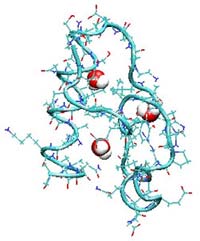Protein folding physics modeled at the atomic level

Researchers at Los Alamos National Laboratory and the University of California, San Diego, have created the first computer simulation of full-system protein folding thermodynamics at the atomic-level. Understanding the basic physics of protein folding could solve one of the grand mysteries of computational biology.
Proteins are the basic building blocks of life and protein folding, the process by which proteins reconfigure themselves – the actions that result in structural change – are the foundation of cellular growth and the health of a biological system. When proteins incorrectly fold the malfunction can give rise to a variety of diseases. The fact that proteins fold has been known since the 1960s, but an understanding of the chemical and physical properties of folding continues to elude scientists.
Understanding how proteins undergo the folding process has largely been studied from a biologist’s point of view, probing actual proteins and studying them with high-powered microscopy techniques. Now, Los Alamos theoretical biophysicist Angel Garcia, along with colleague Jose N. Onuchic of UC San Diego, have created a computer model of protein folding that focuses on the physics of the protein folding, specifically looking at the temperature changes that occur in the process.
Findings were presented at the Rocky Mountain regional meeting of the American Chemical Society, Albuquerque.
Protein complexes can be very large molecules containing millions of atoms, and protein folding is chemically and physically complex. Folding occurs very rapidly as well, with small protein molecules folding in millionths of seconds.
“We have chosen to first look at a comparatively simple protein in water system consisting of about 18,000 atoms, called a 3-heilx bundle, that folds in a fairly simple way and relatively slowly, in about 10 microseconds,” said Garcia. “Our calculation is based on Onuchic’s ’funneling theory’ of protein folding that looks at the ’energy landscape’ of folding and finds that as the protein gets closer and closer to it’s folded state it’s energy gets lower and lower.”
Garcia implemented an algorithm that relies on exhaustive sampling of protein configurations and utilizes massively parallel computing combined with molecular dynamics and a random-sampling Monte Carlo simulation of the thermodynamics. The result is a computer model of the basic physical properties in a simple system that, if correct, should be applicable to even the most complex proteins. “In principle,” said Garcia, “it should work for all proteins.”
The protein folding problem is complex computationally because a protein can adopt many shapes and configurations that grow exponentially based on the number of amino acids in a chain, called a polypeptide. A typical protein has between 60 and 150 amino acids. A typical amino acid, like glutamine, consists of 20 carbon, hydrogen, oxygen and nitrogen atoms.
Garcia’s 18,000-atom computation was completed on 82 parallel processors over about a six-month time frame, translating to more than 34 years of Central Processing Unit time.
Garcia plans to continue working on protein folding physics, creating more complex models that mimic the physics beyond the thermodynamic, with the eventual goal of better understanding the folding process for even the most complex protein structures.
###
Los Alamos National Laboratory is operated by the University of California for the National Nuclear Security Administration (NNSA) of the U.S. Department of Energy and works in partnership with NNSA’s Sandia and Lawrence Livermore national laboratories to support NNSA in its mission.
Los Alamos enhances global security by ensuring the safety and reliability of the U.S. nuclear stockpile, developing technologies to reduce threats from weapons of mass destruction, and solving problems related to energy, environment, infrastructure, health and national security concerns.
Media Contact
More Information:
http://www.lanl.gov.All latest news from the category: Interdisciplinary Research
News and developments from the field of interdisciplinary research.
Among other topics, you can find stimulating reports and articles related to microsystems, emotions research, futures research and stratospheric research.
Newest articles

First-of-its-kind study uses remote sensing to monitor plastic debris in rivers and lakes
Remote sensing creates a cost-effective solution to monitoring plastic pollution. A first-of-its-kind study from researchers at the University of Minnesota Twin Cities shows how remote sensing can help monitor and…

Laser-based artificial neuron mimics nerve cell functions at lightning speed
With a processing speed a billion times faster than nature, chip-based laser neuron could help advance AI tasks such as pattern recognition and sequence prediction. Researchers have developed a laser-based…

Optimising the processing of plastic waste
Just one look in the yellow bin reveals a colourful jumble of different types of plastic. However, the purer and more uniform plastic waste is, the easier it is to…



